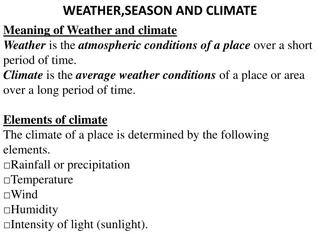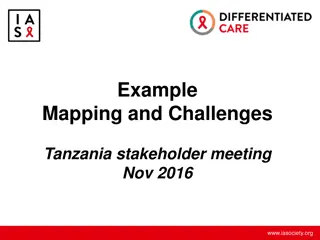
Enhancing NAND Flash Memory Lifetime with Write-hotness Aware Retention Management
Explore how Write-hotness Aware Retention Management (WARM) can significantly improve NAND flash memory lifetime by reducing refresh overhead and optimizing write-hot data retention. Key findings show up to 12.9x improved lifetime with adaptive refresh strategies.
Download Presentation

Please find below an Image/Link to download the presentation.
The content on the website is provided AS IS for your information and personal use only. It may not be sold, licensed, or shared on other websites without obtaining consent from the author. If you encounter any issues during the download, it is possible that the publisher has removed the file from their server.
You are allowed to download the files provided on this website for personal or commercial use, subject to the condition that they are used lawfully. All files are the property of their respective owners.
The content on the website is provided AS IS for your information and personal use only. It may not be sold, licensed, or shared on other websites without obtaining consent from the author.
E N D
Presentation Transcript
WARM Improving NAND Flash Memory Lifetime with Write-hotness Aware Retention Management Yixin Luo, Yu Cai, Saugata Ghose, Jongmoo Choi*, Onur Mutlu Carnegie Mellon University, *Dankook University 1
Executive Summary Flash memory can achieve 50x endurance improvement by relaxing retention time using refresh[Cai+ ICCD 12] Problem: Refreshconsumes the majority of endurance improvement Goal: Reduce refresh overhead to increase flash memory lifetime Key Observation: Refresh is unnecessary for write-hot data Key Ideas of Write-hotness Aware Retention Management (WARM) Physically partition write-hot pages and write-cold pages within the flash drive Apply different policies (garbage collection, wear-leveling, refresh) to each group Key Results WARM w/o refresh improves lifetime by 3.24x WARM w/ adaptive refresh improves lifetime by 12.9x (1.21x over refresh only) 2
Outline Problem and Goal Problem and Goal Key Observations Key Observations WARM: Write WARM: Write- -hotness Aware Retention Management hotness Aware Retention Management Results Results Conclusion Conclusion 3
Outline Problem and Goal Problem and Goal Key Observations Key Observations WARM: Write WARM: Write- -hotness Aware Retention Management hotness Aware Retention Management Results Results Conclusion Conclusion 4
Retention Time Relaxation for Flash Memory Flash memory has limited write endurance Retention timesignificantly affects endurance The duration for which flash memory correctly holds data Retention Time Typical flash retention guarantee 3-year 3000 3-month 8000 Requires refresh to reach this 3-week 20000 3-day 150000 0 50K 100K 150K Endurance (P/E Cycles) [Cai+ ICCD 12] 5
NAND Flash Refresh Flash Correct and Refresh (FCR), Adaptive Rate FCR (ARFCR) [Cai+ ICCD 12] 150000 3000 Extended endurance Unusable endurance (consumed by refresh) Nominal endurance Problem: Flash refresh operations reduce extended lifetime Goal: Reduce refresh overhead, improve flash lifetime 6
Outline Problem and Goal Problem and Goal Key Observations Key Observations WARM: WARM: Write Write- -hotness Aware Retention Management hotness Aware Retention Management Results Results Conclusion Conclusion 7
Observation 1: Refresh Overhead is High 100% % of Extended Endurance 90% Consumed by Refresh 80% 70% 60% 53% 50% 40% 30% 20% 10% 0% 8
Observation 2: Write-Hot Pages Can Skip Refresh Update Retention Effect Write-Hot Page Write-Hot Page Invalid Page Write-Cold Page Write-Cold Page Write-Cold Page Write-Cold Page Invalid Page Write-Cold Page Write-Hot Page Write-Hot Page Invalid Page Write-Hot Page Write-Hot Page Skip Refresh Need Refresh 9
Conventional Write-Hotness Oblivious Management Flash Memory Hot Page 1 Cold Page 2 Hot Page 1 Cold Page 3 Hot Page 4 Cold Page 5 Page 256 Hot Page 1 Page M Read Page 0 Page 257 Hot Page 4 Cold Page 2 Cold Page 3 Cold Page 4 Page M+1 Write Erase Page 1 Page 2 Page 258 Page M+2 Page 255 Hot Page 4 Page 511 Page M+255 Unable to relax retention time for blocks with write-hot and cold pages Flash Controller 10
Key Idea: Write-Hotness Aware Management Flash Memory Hot Page 1 Hot Page 1 Hot Page 4 Hot Page 4 Hot Page 1 Hot Page 4 Hot Page 4 Hot Page 1 Page 256 Cold Page 2 Page 0 Page M Page 257 Cold Page 3 Cold Page 5 Page 1 Page M+1 Page 2 Page 258 Page M+2 Page 255 Hot Page 1 Page 511 Page M+255 Can relax retention time for blocks with write-hot pages only Flash Controller 11
Outline Problem and Goal Problem and Goal Key Observations Key Observations WARM: Write WARM: Write- -hotness Aware Retention Management hotness Aware Retention Management Results Results Conclusion Conclusion 12
WARM Overview Design Goal: Relax retention time w/o refresh for write-hot data only WARM: Write-hotness Aware Retention Management Write-hot/write-cold data partitioning algorithm Write-hotness aware flash policies Partition write-hot and write-cold data into separate blocks Skip refreshes for write-hot blocks More efficient garbage collection and wear-leveling 13
Write-Hot/Write-Cold Data Partitioning Algorithm Cold Virtual Queue TAIL HEAD Cold Data 1. Initially, all data is cold and is stored in the cold virtual queue. 14
Write-Hot/Write-Cold Data Partitioning Algorithm Cold Virtual Queue TAIL HEAD Cold Data 2. On a write operation, the data is pushed to the tail of the cold virtual queue. 15
Write-Hot/Write-Cold Data Partitioning Algorithm Cold Virtual Queue TAIL HEAD Cold Data Recently-written data is at the tail of cold virtual queue. 16
Write-Hot/Write-Cold Data Partitioning Algorithm Hot Virtual Queue TAIL Cold Virtual Queue TAIL HEAD Hot Data Cold Data Hot Window Cooldown Window 3, 4. On a write hit in the cooldown window, the data is promoted to the hot virtual queue. 17
Write-Hot/Write-Cold Data Partitioning Algorithm Hot Virtual Queue TAIL Cold Virtual Queue HEAD TAIL HEAD Hot Data Cold Data Hot Window Cooldown Window Data is sorted by write-hotness in the hot virtual queue. 18
Write-Hot/Write-Cold Data Partitioning Algorithm Hot Virtual Queue TAIL Cold Virtual Queue HEAD TAIL HEAD Hot Data Cold Data Hot Window Cooldown Window 5. On a write hit in hot virtual queue, the data is pushed to the tail. 19
Write-Hot/Write-Cold Data Partitioning Algorithm Hot Virtual Queue TAIL Cold Virtual Queue HEAD TAIL HEAD Hot Data Cold Data Hot Window Cooldown Window 6. Unmodified hot data will be demoted to the cold virtual queue. 20
Conventional Flash Management Policies Flash Translation Layer (FTL) Map data to erased blocks Translate logical page number to physical page number Garbage Collection Triggered before erasing a victim block Remap all valid data on the victim block Wear-leveling Triggered to balance wear-level among blocks 21
Write-Hotness Aware Flash Policies Flash Drive Hot Block Pool Cold Block Pool Block 10 Block 10 Block 11 Block 11 Block 3 Block 3 Block 0 Block 0 Block 1 Block 1 Block 2 Block 2 Block 4 Block 4 Block 5 Block 5 Block 6 Block 6 Block 7 Block 7 Block 8 Block 8 Block 9 Block 9 Write-hot data naturally relaxed retention time Write-cold data lower write frequency, less wear-out Program in block order Garbage collect in block order All blocks naturally wear-leveled Conventional garbage collection Conventional wear-leveling algorithm 22
Dynamically Sizing the Hot and Cold Block Pools All blocks are divided between the hot and cold block pools 1. Find the maximum hot pool size 2. Reduce hot virtual queue size to maximize cold pool lifetime 3. Size the cooldown window to minimize ping-ponging of data between the two pools 23
Outline Problem and Goal Problem and Goal Key Observations Key Observations WARM: WARM: Write Write- -hotness Aware Retention Management hotness Aware Retention Management Results Results Conclusion Conclusion 24
Methodology DiskSim 4.0 + SSD model Parameter Value Page read to register latency 25 s Page write from register latency 200 s Block erase latency 1.5 ms Data bus latency 50 s Page/block size 8 KB/1 MB Die/package size 8 GB/64 GB Total capacity 256 GB Over-provisioning 15% Endurance for 3-year retention time 3,000 PEC Endurance for 3-day retention time 150,000 PEC 25
WARM Configurations WARM WARM- -Only Relax retention time in hot block pool only No refresh needed WARM+FCR WARM+FCR First apply WARM WARM- -Only Only Then also relax retention time in cold block pool Refresh cold blocks every 3 days WARM+ARFCR WARM+ARFCR Relax retention time in both hot and cold block pools Adaptively increase the refresh frequency over time Only 26
Flash Lifetime Improvements WARM+ARFCR 21% 16 Normalized Lifetime Improvement 14 12.9x WARM+FCR 30% 12 10 8 WARM-Only 3.24x 6 4 2 0 Baseline WARM-Only FCR WARM+FCR ARFCR WARM+ARFCR 27
WARM-Only Endurance Improvement Cold pool Hot pool 600% 500% Endurance 3.58x 400% 300% 200% 100% 0% 28
WARM+FCR Refresh Operation Reduction 100% FCR WARM+FCR 90% 80% % of Refresh Writes 70% 53%48% 60% 50% 40% 30% 20% 10% 0% 29
WARM Performance Impact Worst Case: < 6% 106% Avg. Resp. Time Avg. Case: < 2% Normalized 104% 102% 100% 98% 30
Other Results in the Paper Breakdown of write frequency Breakdown of write frequency into host writes, garbage collection writes, refresh writes in the hot and cold block pools WARM reduces refresh writes significantly while having low garbage collection overhead Sensitivity to different capacity over Sensitivity to different capacity over- -provisioning amounts WARM improves flash lifetime more as over-provisioning increases provisioning amounts Sensitivity to different refresh intervals Sensitivity to different refresh intervals WARM improves flash lifetime more as refresh frequency increases 31
Outline Problem and Goal Problem and Goal Key Observations Key Observations WARM: WARM: Write Write- -hotness Aware Retention Management hotness Aware Retention Management Results Results Conclusion Conclusion 32
Conclusion Flash memory can achieve 50x endurance improvement by relaxing retention time using refresh[Cai+ ICCD 12] Problem: Refreshconsumes the majority of endurance improvement Goal: Reduce refresh overhead to increase flash memory lifetime Key Observation: Refresh is unnecessary for write-hot data Key Ideas of Write-hotness Aware Retention Management (WARM) Physically partition write-hot pages and write-cold pages within the flash drive Apply different policies (garbage collection, wear-leveling, refresh) to each group Key Results WARM w/o refresh improves lifetime by 3.24x WARM w/ adaptive refresh improves lifetime by 12.9x (1.21x over refresh only) 33
WARM Improving NAND Flash Memory Lifetime with Write-hotness Aware Retention Management Yixin Luo, Yu Cai, Saugata Ghose, Jongmoo Choi*, Onur Mutlu Carnegie Mellon University, *Dankook University 34
Related Work: Retention Time Relaxation Perform periodic refresh periodic refresh on data to relax retention time [Cai+ ICCD 12, Cai+ ITJ 13, Liu+ DAC 13, Pan+ HPCA 12] Fixed-frequency refresh (e.g., FCR) Adaptive refresh (e.g., ARFCR): incrementally increase refresh freq. Incurs a high overhead, since block-level erase/rewrite required WARM can work alongside periodic refresh Refresh using rewriting codes [Li+ ISIT 14] Avoids block-level erasure Adds complex encoding/decoding circuitry into flash memory 36
Related Work: Hot/Cold Data Separation in FTLs Mechanisms with statically Multi-level hash tables to improve FTL latency [Lee+ TCE 09, Wu+ ICCAD 06] Sorted tree for wear-leveling [Chang SAC 07] Log buffer migration for garbage collection [Lee+ OSR 08] Multiple static queues for garbage collection [Chang+ RTAS 02, Chiang SPE 99, Jung CSA 13] Static window sizing bad for WARM Number of write-hot pages changes over time Undersized: reduced benefits reduced benefits Oversized: data loss data loss of cold pages incorrectly in hot page window statically- -sized sized windows/bins for partitioning 37
Related Work: Hot/Cold Data Separation in FTLs Estimating page update frequency for dynamic Using most recent re-reference distance for garbage collection [Stoica VLDB 13] or for write buffer locality [Wu+ MSST 10] Using multiple Bloom filters for garbage collection [Park MSST 11] Prone to false positives: increased migration for WARM Reverse translation to logical page no. consumes high overhead Placing write-hot data in worn worn- -out pages Assumes SSD w/o refresh Benefits limited by number of worn-out pages in SSD Hot data pool size cannot be dynamically adjusted dynamic partitioning out pages[Huang+ EuroSys 14] 38
Related Work: Non-FTL Hot/Cold Data Separation These works all use multiple statically Reference counting for garbage collection [Joao+ ISCA 09] Cache replacement algorithms [Johnson+ VLDB 94, Megiddo+ FAST 03, Zhou+ ATC 01] Static window sizing bad for WARM Number of write-hot pages changes over time Undersized: reduced benefits reduced benefits Oversized: data loss data loss of cold pages incorrectly in hot page window statically- -sized sized queues 39
Other Work by SAFARI on Flash Memory J. Meza, Q. Wu, S. Kumar, and O. Mutlu. A A Large Y. Cai, Y. Luo, S. Ghose, E. F. Haratsch, K. Mai, O. Mutlu. Read Mitigation Mitigation, DSN 2015. Y. Cai, Y. Luo, E. F. Haratsch, K. Mai, O. Mutlu. Data Recovery Recovery, HPCA 2015. Y. Cai, G. Yalcin, O. Mutlu, E. F. Haratsch, O. Unsal, A. Cristal, K. Mai. Neighbor Memories Memories, SIGMETRICS 2014. Y. Cai, O. Mutlu, E. F. Haratsch, K. Mai. Program ICCD 2013. Y. Cai, G. Yalcin, O. Mutlu, E. F. Haratsch, A. Cristal, O. Unsal, K. Mai. Error Flash Flash Memory Memory, Intel Technology Jrnl. (ITJ), Vol. 17, No. 1, May 2013. Y. Cai, E. F. Haratsch, O. Mutlu, K. Mai. Threshold Modeling Modeling, DATE 2013. Y. Cai, G. Yalcin, O. Mutlu, E. F. Haratsch, A. Cristal, O. Unsal, K. Mai. Flash for Increased Flash Memory for Increased Flash Memory Lifetime Lifetime, ICCD 2012. Y. Cai, E. F. Haratsch, O. Mutlu, K. Mai. Error 2012. Large- -Scale Study of Flash Memory Errors in the Scale Study of Flash Memory Errors in the Field Field, SIGMETRICS 2015. Read Disturb Errors in MLC NAND Flash Memory: Characterization and Disturb Errors in MLC NAND Flash Memory: Characterization and Data Retention in MLC NAND Flash Memory: Characterization, Optimization and Retention in MLC NAND Flash Memory: Characterization, Optimization and Neighbor- -Cell Cell Assisted Error Correction for MLC NAND Flash Assisted Error Correction for MLC NAND Flash Program Interference in MLC NAND Flash Memory: Characterization, Modeling, and Interference in MLC NAND Flash Memory: Characterization, Modeling, and Mitigation Mitigation, Error Analysis and Retention Analysis and Retention- -Aware Error Management for NAND Aware Error Management for NAND Threshold Voltage Distribution in MLC NAND Flash Memory: Characterization, Analysis and Voltage Distribution in MLC NAND Flash Memory: Characterization, Analysis and Flash Correct Correct- -and and- -Refresh: Retention Refresh: Retention- -Aware Error Management Aware Error Management Error Patterns in MLC NAND Flash Memory: Measurement, Characterization, and Patterns in MLC NAND Flash Memory: Measurement, Characterization, and Analysis Analysis, DATE 40
References [Cai+ ICCD 12] Y. Cai, G. Yalcin, O. Mutlu, E. F. Haratsch, A. Cristal, O. Unsal, K. Mai. Flash Correct Management for Increased Flash Memory Lifetime Management for Increased Flash Memory Lifetime, ICCD 2012. [Cai+ ITJ 13] Y. Cai, G. Yalcin, O. Mutlu, E. F. Haratsch, A. Cristal, O. Unsal, K. Mai. Error Analysis and Retention Management for NAND Flash Memory Management for NAND Flash Memory, Intel Technology Jrnl. (ITJ), Vol. 17, No. 1, May 2013. [Chang SAC 07] L.-P. Chang. On Efficient Wear Leveling for Large On Efficient Wear Leveling for Large- -Scale Flash [Chang+ RTAS 02] L.-P. Chang, T.-W. Kuo. An An Adaptive Striping Architecture Adaptive Striping Architecture for Flash RTAS 2002. [Chiang SPE 99] M.-L. Chiang, P. C. H. Lee, R.-C. Chang. Using Software: Practice & Experience (SPE), 1999. [Huang+ EuroSys 14] P. Huang, G. Wu, X. He, W. Xiao. An Performance Degradation Performance Degradation, EuroSys 2014. [Joao+ ISCA 09] J. A. Joao, O. Mutlu, Y. N. Patt. Flexible Reference . Flexible Reference- -Counting 2009. [Johnson+ VLDB 94] T. Johnson, D. Shasha. 2Q 2Q: A Low Overhead High : A Low Overhead High Performance Buffer 1994. [Jung CSA 13] T. Jung, Y. Lee, J. Woo, I. Shin. Double Double Hot/Cold Clustering Hot/Cold Clustering for Solid Flash Correct- -and and- -Refresh: Retention Refresh: Retention- -Aware Error Aware Error Error Analysis and Retention- -Aware Error Aware Error Scale Flash- -Memory Storage Systems Memory Storage Systems, SAC 2007. for Flash Memory Storage Systems of Embedded Systems Memory Storage Systems of Embedded Systems, Using Data Data Clustering to Clustering to Improve Cleaning Performance for Flash Memory Improve Cleaning Performance for Flash Memory, An Aggressive Aggressive Worn Worn- -out Flash out Flash Block Management Scheme to Alleviate SSD Block Management Scheme to Alleviate SSD Counting- -Based Based Hardware Acceleration for Garbage Collection Hardware Acceleration for Garbage Collection, ISCA Performance Buffer Management Replacement Algorithm Management Replacement Algorithm, VLDB for Solid State Drives State Drives, CSA 2013. 41
References [Lee+ OSR 08] S. Lee, D. Shin, Y.-J. Kim, J. Kim. LAST: Locality ACM SIGOPS Operating Systems Review (OSR), 2008. [Lee+ TCE 09] H.-S. Lee, H.-S. Yun, D.-H. Lee. HFTL: Hybrid Flash Translation Layer Based on Hot Data Identification for Flash Memory HFTL: Hybrid Flash Translation Layer Based on Hot Data Identification for Flash Memory, IEEE Trans. Consumer Electronics (TCE), 2009. [Li+ ISIT 14] Y. Li, A. Jiang, J. Bruck. Error Error Correction and Partial Correction and Partial Information Rewriting Information Rewriting for Flash Memories [Liu+ DAC 13] R.-S. Liu, C.-L. Yang, C.-H. Li, G.-Y. Chen. DuraCache DuraCache: : A Durable [Megiddo+ FAST 03] N. Megiddo, D. S. Modha. ARC ARC: A Self : A Self- -Tuning, Low Tuning, Low Overhead Replacement [Pan+ HPCA 12] Y. Pan, G. Dong, Q. Wu, T. Zhang. Quasi Quasi- -Nonvolatile SSD: Trading Nonvolatile SSD: Trading Flash Memory System Performance System Performance for Enterprise Applications for Enterprise Applications, HPCA 2012. [Park MSST 11] D. Park, D. H. Du. Hot Hot Data Identification for Data Identification for Flash Flash- -Based Storage [Stoica VLDB 13] R. Stoica and A. Ailamaki. Improving Flash Write Performance by Using Update Frequency Improving Flash Write Performance by Using Update Frequency, VLDB 2013. [Wu+ ICCAD 06] C.-H. Wu, T.-W. Kuo. An An Adaptive Two Adaptive Two- -Level Management Level Management for the 2006. [Wu+ MSST 10] G. Wu, B. Eckart, X. He. BPAC BPAC: An Adaptive Write : An Adaptive Write Buffer Management Buffer Management Scheme for Flash 2010. [Zhou+ ATC 01] Y. Zhou, J. Philbin, K. Li. The The Multi Multi- -Queue Queue Replacement Algorithm Replacement Algorithm for Second Level LAST: Locality- -Aware Sector Translation for NAND Flash Memory Aware Sector Translation for NAND Flash Memory- -Based Storage Systems Based Storage Systems, for Flash Memories, ISIT 2014. A Durable SSD Cache Using MLC NAND Flash SSD Cache Using MLC NAND Flash, DAC 2013. Overhead Replacement Cache Cache, FAST 2003. Flash Memory Nonvolatility Nonvolatility to Improve Storage to Improve Storage Based Storage Systems Using Multiple Bloom Filters Systems Using Multiple Bloom Filters, MSST 2011. for the Flash Translation Layer in Embedded Systems Flash Translation Layer in Embedded Systems, ICCAD Scheme for Flash- -based Solid State Drives based Solid State Drives, MSST for Second Level Buffer Caches Buffer Caches, USENIX ATC 2001. 42
Workloads Studied Synthetic Workloads Trace Source Length Description Trace Source Length Description iozone IOzone 16 min File system benchmark postmark Postmark 8.3 min File system benchmark Real-World Workloads Trace Source Length Description Trace Source Length Description financial UMass 1 day Online transaction processing rsrch MSR 7 days Research projects homes FIU 21 days Research group activities src MSR 7 days Source control web-vm FIU 21 days Web mail proxy server stg MSR 7 days Web staging hm MSR 7 days Hardware monitoring ts MSR 7 days Terminal server prn MSR 7 days Print server usr MSR 7 days User home directories proj MSR 7 days Project directories wdev MSR 7 days Test web server prxy MSR 7 days Firewall/web proxy web MSR 7 days Web/SQL server 43
Highly-Skewed Distribution of Write Activity Small amount of write-hot data generates large fraction of writes. 45
WARM-Only vs. Baseline Normalized Lifetime 5 Improvement 4 3 2 1 0 prn rsrch src stg usr proj ts wdev web homes iozone postmark hm prxy web-vm GMean financial 46
WARM+FCR vs. FCR-Only Normalized Lifetime 1.6 Improvement 1.4 1.2 1.0 0.8 0.6 prn rsrch src stg usr proj ts wdev web homes iozone postmark hm prxy web-vm GMean financial 47
WARM+ARFCR vs. ARFCR-Only Normalized Lifetime 1.6 Improvement 1.4 1.2 1.0 0.8 0.6 prn rsrch src stg usr proj ts wdev web homes iozone postmark hm prxy web-vm GMean financial 48
Sensitivity to Capacity Over-Provisioning Baseline WARM+FCR WARM-Only ARFCR FCR WARM+ARFCR 16 Normalized Lifetime Improvement 8 4 2 1 0 15% Capacity Over-provisioning 30% Capacity Over-provisioning 50






















